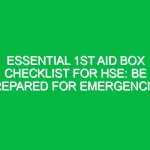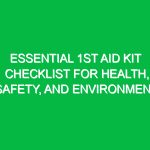Introduction
Good morning, team! Today, we’re going to conduct a Toolbox Talk focused on a critical topic in our industry: Falls in the Construction Industry. Falls are one of the leading causes of serious injuries and fatalities on construction sites. Understanding how to prevent these accidents is essential for maintaining a safe working Environment. In this discussion, we will explore the risks associated with falls, safety measures we can implement, and our responsibilities in preventing such incidents.
Understanding the Risks
The Statistics
According to the Occupational Safety and Health Administration (OSHA), falls account for approximately 33% of all construction-related fatalities. This statistic highlights the importance of addressing Fall Hazards proactively. Whether you’re working on scaffolding, ladders, or roofs, the risk of falling is ever-present. Let’s delve into some common scenarios where falls can occur:
- Working from heights such as ladders and scaffolding.
- Slips and trips on uneven surfaces.
- Improper use of Fall Protection equipment.
Identifying Potential Hazards
Before we can prevent falls, we need to identify potential Hazards on our worksite. Here are some common hazards related to falls in the construction industry:
- Unprotected edges: Openings in floors or roofs without guardrails.
- Improperly maintained ladders: Worn-out rungs or unstable footing.
- Slippery surfaces: Wet floors, especially after rain or spills.
- Inadequate Training: Lack of knowledge about using fall protection equipment.
The Importance of Fall Protection
Implementing proper fall protection measures is crucial for safeguarding our team. Falls in the construction industry can lead to severe injuries, long-term disabilities, or even fatalities. Not only do these incidents affect the individuals involved, but they also have broader implications for the entire team and company. An injury can lead to project delays, increased insurance costs, and a negative impact on morale.
Regulatory Standards and Compliance
It’s essential to understand that fall protection isn’t just a recommendation; it’s required by law. osha has set forth Regulations that mandate fall protection measures. These regulations are designed to ensure that appropriate Safety standards are met. Compliance with such regulations helps protect not only our workers but also the company from legal liabilities.
Best Practices for Fall Prevention
1. Use Fall Protection Equipment
Always utilize appropriate fall protection equipment when working at heights. This includes:
- Harnesses: Ensure they are properly fitted and inspected before use.
- Guardrails: Install guardrails around open edges or holes.
- Lanyards and Anchors: Use these to secure yourself when working on elevated surfaces.
2. Maintain Your Equipment
Regularly inspect and maintain ladders, scaffolds, and other equipment. Ensure that:
- Ladders are free of defects and have stable footing.
- Scaffolding is erected properly and inspected daily.
- Tools and materials are stored safely to prevent trips and falls.
3. Keep Work Areas Clean
A clean worksite is a safer worksite. To minimize slip and trip hazards:
- Clear debris, tools, and materials from walkways.
- Address spills immediately and use cones or signage to warn of wet surfaces.
- Organize materials to limit clutter on the ground.
4. Training and Awareness
Proper training is vital for ensuring that every team member understands fall hazards and how to mitigate them. This includes:
- Understanding the correct use of fall protection equipment.
- Recognizing potential hazards in the work environment.
- Participating in regular Safety meetings and Toolbox Talks.
Real-Life Examples and Scenarios
Scenario 1: Working from Heights
Imagine a worker named John who is tasked with installing a roof. He decides to use a ladder that appears stable, but he fails to check the ground beneath it. As he climbs, the ladder shifts, causing him to lose balance and fall. If John had taken the time to inspect the ladder and its positioning, he could have prevented the fall.
Scenario 2: Slippery Surfaces
Consider a rainy day on our construction site. Workers are moving materials across a wet surface. One worker slips and falls because no one placed warning signs. This incident highlights the importance of immediate action regarding changing conditions and being proactive about site safety.
Encouraging Open Communication
As we discuss falls in the construction industry, I want to emphasize the importance of communication. If you see a potential hazard, speak up! Reporting unsafe conditions can prevent accidents. Ask yourself:
- Is there a potential fall hazard nearby?
- Have I properly communicated safety concerns to my supervisor?
- Am I aware of the safety protocols in place?
The Role of Teamwork
Safety isn’t just an individual responsibility; it’s a team effort. Let’s support one another in creating a culture of safety. This means:
- Looking out for each other and offering help when someone is working at heights.
- Encouraging your teammates to use safety equipment consistently.
- Participating in safety drills and training sessions actively.
Conclusion
In closing, remember that preventing falls in the construction industry is not only about compliance; it’s about protecting lives. By being proactive, using the right equipment, maintaining a clean workspace, and communicating effectively, we can significantly reduce the risk of falls on our job sites.
Thank you for your attention and commitment to safety today. Let’s work together to ensure that everyone returns home safely at the end of each workday. If you have any questions or suggestions about improving safety practices, now is the time to share them!


